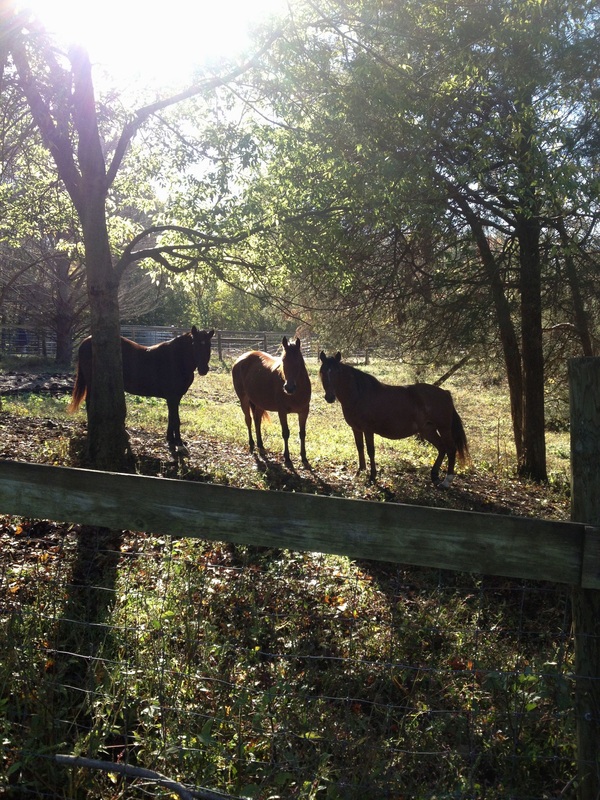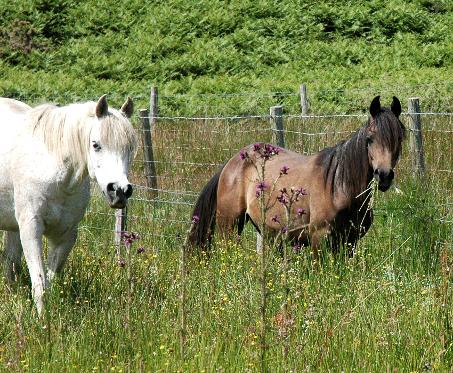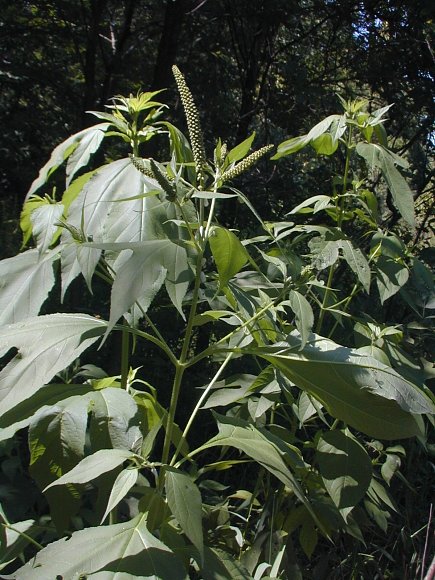Pasture Weeds: Noxious Plants or Nutritious Herbs?
During October in southern Indiana, pasture grass is beginning to turn brown and our horses are sampling several different weeds that grow along the fence rows. One of their favorites is giant ragweed, which is also eaten in the summer when the grass is green and moist.
If you read the equine literature very little has been written about the mineral content of weeds, which can form a significant part of equine diets. In nutrient-poor soils, the roots of pasture plants, such as grasses and weeds, have some ability to selectively absorb and concentrate essential minerals. For example, Harrington et al. (2006) determined that weeds, such as chicory, dandelion, narrow-leaved plantain and others, have elevated concentrations of several different minerals relative to conventional pasture forage. The weeds were sampled from both conventional and organic plots on silt loam (soil texture with high proportion of silt to sand and clay) within the Dairy Cattle Research Unit of Massey University, Palmerston North, New Zealand.
If you are interested in crude protein content, digestibility and nutritive value of weeds in terms of maturity, refer to this article published by the Virginia Cooperative Extension.
In the wild, animals self-select certain plants that provide a source of natural medicines for healing and essential minerals for a balanced diet (a good reference is the book by Cindy Engel on Wild Health: How Animals Keep Themselves Well and What We Can Learn from Them). We can try to mimic this natural behavior for our horses by cultivating “herb” gardens for self-selection, or allowing beneficial weeds to grow in our pastures (Figs. 1 and 2).
If you read the equine literature very little has been written about the mineral content of weeds, which can form a significant part of equine diets. In nutrient-poor soils, the roots of pasture plants, such as grasses and weeds, have some ability to selectively absorb and concentrate essential minerals. For example, Harrington et al. (2006) determined that weeds, such as chicory, dandelion, narrow-leaved plantain and others, have elevated concentrations of several different minerals relative to conventional pasture forage. The weeds were sampled from both conventional and organic plots on silt loam (soil texture with high proportion of silt to sand and clay) within the Dairy Cattle Research Unit of Massey University, Palmerston North, New Zealand.
If you are interested in crude protein content, digestibility and nutritive value of weeds in terms of maturity, refer to this article published by the Virginia Cooperative Extension.
In the wild, animals self-select certain plants that provide a source of natural medicines for healing and essential minerals for a balanced diet (a good reference is the book by Cindy Engel on Wild Health: How Animals Keep Themselves Well and What We Can Learn from Them). We can try to mimic this natural behavior for our horses by cultivating “herb” gardens for self-selection, or allowing beneficial weeds to grow in our pastures (Figs. 1 and 2).
Unfortunately, many common weeds are classified as noxious plants, which are usually controlled with toxic herbicides, such as 2,4-D. Boivin et al. (2005) determined that the fate and transport of 2,4-D was dependent on both time and soil type. For clay and loamy soils, characteristic of Harrison County, Indiana, about 50% of 2,4-D was still available (mobile) after 10 days. An incubation period of 60 days in the soil is necessary before almost all of the 2,4-D (98%) is unavailable for transport.
Fig 1. Wild mustangs at Mitchell Plain Farm in weeded area on a cool sunny morning in October. Photo by GA Lager
Fig. 2. Raising horses naturally. Susan Duckworth's Arabians on pasture in the U.K. http://www.bitlessandbarefoot.com/keeping-horses-naturally.php
We decided to determine macronutrients and micronutrients (i.e., major and trace minerals) for some of the more palatable (and controllable) weeds in this region and see if we could find several good candidates for self-selection in small pasture plots. At this time of year (August-September), some of the weeds had very fibrous stalks with seed heads, e.g., ragweed and chicory. With the exception of chicory, only one sample of each weed was collected (no replicates). Chicory was sampled twice to evaluate the nutrient distribution between basal leaf rosette (vegetative state) and flowering stalk (reproduction stage) (Fig 3.). Hay samples consisted of cores taken from 12-20 representative bales. No fertilizers other than composted horse manure were applied to pastures. The Dairy One Forage Laboratory, Ithaca, New York, analyzed weed and hay samples using ICP spectroscopy (inductively coupled plasma spectroscopy).
Fig. 3. Chicory in reproduction stage, photo from https://en.wikipedia.org/wiki/Chicory
Some of the results from Harrington et al. (2006) and our new analyses of weed and hay samples are compared below in Tables 1 and 2. Note that the unusually high sodium (Na) concentrations in the New Zealand data are due to atmospheric deposition of sea salt. Several of the weeds analyzed in our study are enriched in both major and trace minerals relative to local grass and legume hays, consistent with the study by Harrington et al. (2006). For example, calcium (Ca) in ragweed and Jerusalem artichoke is ~50% higher than that in alfalfa–rich hay (Table 1). Zinc (Zn) is enriched in all weeds (Table 2). The highest copper (Cu) concentration is found in ragweed, chicory and Jerusalem artichoke, which are also good sources of phosphorous (P,) magnesium (Mg) and potassium (K).
Ragweed leaves are chock-full of minerals and the seeds are a great energy source (47% crude protein and 37% fat). It has been suggested that native Americans once cultivated Ragweed seeds before the appearance of maize (corn). The oil extracted from boiling the seeds might have been used as a fat source (82% linoleic, or omega-6, fatty acid and 15% oleic, or omega-9, fatty acid), sustaining populations during famines (see Green Deane's post on ragweed). Crude protein and digestibility (the latter estimated by acid detergent fiber) of ragweed leaves are equal to those of alfalfa. Our horses and donkeys eat both the leaves and seeds. However, if you have allergies this is not a plant you want to propagate in your pasture because the pollen grains are the major cause of late summer/fall allergies (Fig. 4). The alternative is to maintain existing stands in selected pasture areas.
Ragweed leaves are chock-full of minerals and the seeds are a great energy source (47% crude protein and 37% fat). It has been suggested that native Americans once cultivated Ragweed seeds before the appearance of maize (corn). The oil extracted from boiling the seeds might have been used as a fat source (82% linoleic, or omega-6, fatty acid and 15% oleic, or omega-9, fatty acid), sustaining populations during famines (see Green Deane's post on ragweed). Crude protein and digestibility (the latter estimated by acid detergent fiber) of ragweed leaves are equal to those of alfalfa. Our horses and donkeys eat both the leaves and seeds. However, if you have allergies this is not a plant you want to propagate in your pasture because the pollen grains are the major cause of late summer/fall allergies (Fig. 4). The alternative is to maintain existing stands in selected pasture areas.
Fig. 4. Giant ragweed in late summer with flower spikes, photo by Illinois Wild Flowers
The best choices for cultivation based on our study and the results of Harrington et al. (2006) are chicory, dandelion, narrow-leaved plantain (Buckhorn plantain) and Jerusalem artichoke (Fig. 5), all of which are good sources of Cu and Zn, two minerals deficient in almost all hay and pasture. Cu and Zn concentrations in chicory are highest when the plant is grazed in the vegetative state during leaf growth stage (Table 2).
In a balanced equine diet, target ratios for the ratios Ca/Mg and Ca/P are ~ 2:1. Both ratios are significantly higher in some of the weeds listed in Table 1 and range from 7.4:1 (Ca:P in narrow-leaved plantain) to 2.7:1 (Ca:Mg in chicory vegetative state). For comparison, the Ca:P and Ca:Mg ratios in our alfalfa-rich hay are 6.6:1 and 4.5:1, respectively. Note that self-selection plots represent only a small percentage of pasture forage and would not be problem unless these weeds are the only feed source.
Keep in mind that the concentrations of plant nutrients do not necessarily reflect the actual amounts absorbed by equines because of antagonistic effects, i.e., the interaction between two minerals has a negative effect on the absorption of one of the minerals. The negative effect of Fe on the absorption of Zn is a good example, as discussed previously.
In a balanced equine diet, target ratios for the ratios Ca/Mg and Ca/P are ~ 2:1. Both ratios are significantly higher in some of the weeds listed in Table 1 and range from 7.4:1 (Ca:P in narrow-leaved plantain) to 2.7:1 (Ca:Mg in chicory vegetative state). For comparison, the Ca:P and Ca:Mg ratios in our alfalfa-rich hay are 6.6:1 and 4.5:1, respectively. Note that self-selection plots represent only a small percentage of pasture forage and would not be problem unless these weeds are the only feed source.
Keep in mind that the concentrations of plant nutrients do not necessarily reflect the actual amounts absorbed by equines because of antagonistic effects, i.e., the interaction between two minerals has a negative effect on the absorption of one of the minerals. The negative effect of Fe on the absorption of Zn is a good example, as discussed previously.
Fig. 5. Jerusalem artichoke in bloom. Photo by GA Lager
This is a preliminary study. A more systematic, scientific approach with replicate samples would be needed to fully evaluate the use of weeds as nutritional supplements in equines. Future studies could also include carbohydrate content (sugars and starches) as well as mineral content. The nutrient concentrations in Tables 1 and 2 are specific to our local area and will vary depending on soil type, pasture fertilization and maturity stage of weeds sampled.
Your browser does not support viewing this document. Click here to download the document.
Copyright George Lager, 2011-2023. All Rights Reserved (®)




